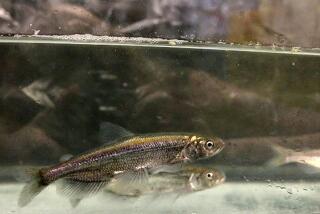Take the gnatcatcher off the endangered list? Here’s why wildlife officials say no
Federal wildlife authorities on Tuesday said that a review of genetic tests has led them to conclude that the coastal California gnatcatcher is a valid subspecies and therefore worthy of protections that have barred development on tens of thousands of acres of prime Southern California real estate for two decades.
The U.S. Fish and Wildlife Service’s finding was in response to a 2014 petition filed by the Pacific Legal Foundation on behalf of developers who argued that DNA analysis showed the gnatcatcher was no different from other types of gnatcatchers that are thriving from the Palos Verdes Peninsula to the southern tip of Baja California.
The developers’ petition was based on DNA analysis by a team of scientists led by Robert Zink, a professor of biology at the University of Minnesota and George Barrowclough, associate curator of ornithology at the American Museum of Natural History in New York.
Many species like the gnatcatcher remain listed even when they are not actually threatened or endangered.
— Harold Johnson, spokesman for the Pacific Legal Foundation
Their peer-reviewed conclusion, published in 2013 in the AUK, a scientific journal and official publication of the American Ornithologists’ Union, was that the small songbird, which often resides year-round in patches of sage and beavertail cactus with panoramic views of the Pacific Ocean, was not a distinct subspecies.
This finding contradicted a century’s worth of work based on evidence of physical differences between the coastal California gnatcatcher and gnatcatchers found elsewhere. The coastal gnatcatcher has less white in its tail feathers, for example. Its call notes are also distinctive: they mew like kittens.
It was Zink’s second such finding about the bird. In 2010, the Pacific Legal Foundation filed a petition based on an earlier DNA analysis of gnatcatcher cells by Zink. The Fish and Wildlife Service turned down that petition but did not dispute the findings, instead suggesting that the petitioners conduct a deeper analysis probing the nucleus of gnatcatcher cells.
Zink’s 2013 analysis did that, and Fish and Wildlife then launched an 18-month review that included a panel of six independent scientists to study the more complete DNA analysis and additional critiques by experts including John E. McCormack, director of the Moore Laboratory of Zoology at Occidental College in Los Angeles.
McCormack concluded that Zink’s genetic data reflected an inadequate sampling of the gnatcatcher’s genome and was not sufficient to overturn research to the contrary.
Jane Hendron, a spokeswoman for Fish and Wildlife, , said the panelists also pointed to weaknesses in the Zink paper including a failure to take into account “a full suite of characteristics.”
Zink could not be reached for comment. But Harold Johnson, a spokesman for the Pacific Legal Foundation, said his organization and its clients were “disappointed” with Fish and Wildlife’s determination.
“The Endangered Species Act requires the best use of the best available scientific evidence and methods, which Dr. Zink’s analysis is,” he said.
As the result of the Fish and Wildlife Service’s interpretation, he said, “many species like the gnatcatcher remain listed even when they are not actually threatened or endangered, diverting government and social resources from more pressing priorities.”
McCormack, however, said that “the agency’s determination was based on new information showing the initial analysis by Zink was not appropriate.”
DNA analysis has undergone revolutionary improvements over the past decade, transforming the once dusty old museum science of taxonomy and revealing so many new species that scientists give them codes until formal names can be assigned.
The advanced technology is revealing immense genetic diversity within species from bacteria to mammals and allowing scientists to understand ecologies and environments in greater detail than ever before.
But Brad Shaffer, an evolutionary biologist at UCLA, noted in an earlier interview that “all those sophisticated maps of genetic composition say nothing about their use in setting ethical conservation policy.”
Making those decisions, he said, “is the realm of regulators and lawmakers in charge of endangered species legislation based on the best available science.”
If Fish and Wildlife had agreed with Zinc, it could have eventually allowed development in about 197,000 acres in Los Angeles, Orange, San Diego, Ventura, Riverside and San Bernardino counties designated as critical habitat for the coastal California gnatcatcher, which became a divisive national symbol when it was listed in 1993.
Today, there are an estimated 2,900 coastal California gnatcatchers left in the United States, federal wildlife authorities said.
MORE LOCAL NEWS
Checking in on some of the secrets to life, love and a bright future
Finally, a disturbing trend in education shows signs of reversal
More to Read
Sign up for Essential California
The most important California stories and recommendations in your inbox every morning.
You may occasionally receive promotional content from the Los Angeles Times.










